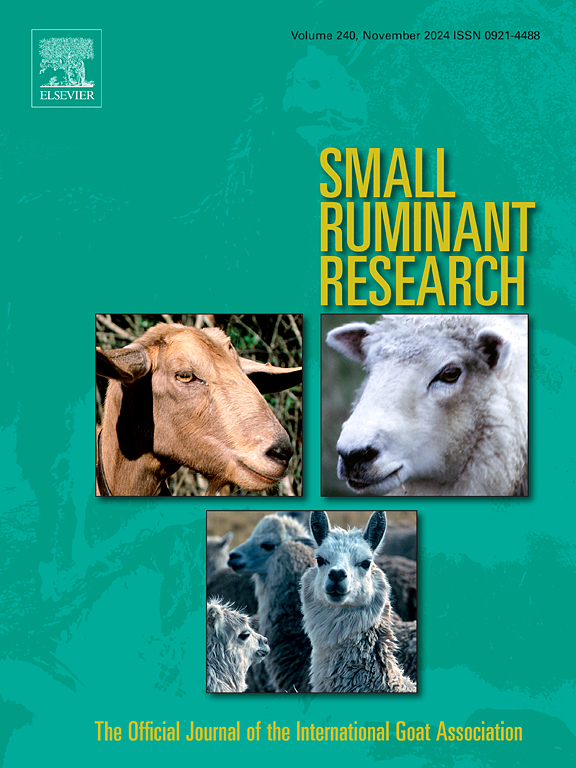两种长效乳内抗菌剂治疗奶山羊非金黄色葡萄球菌所致亚临床乳腺炎的疗效观察
IF 1.6
3区 农林科学
Q2 AGRICULTURE, DAIRY & ANIMAL SCIENCE
引用次数: 0
摘要
非金黄色葡萄球菌是奶山羊亚临床乳腺炎最常见的原因。本研究的目的是描述美国商业山羊奶牛场亚临床乳腺炎病原体的流行情况,并评估乳内抗菌剂治疗由nas引起的亚临床乳腺炎的疗效。参加本研究的是IA, WI或CA三个商业奶牛场之一的居民。入选标准包括无临床乳腺炎证据,两个功能正常的乳房,干燥前30天内未进行抗菌或抗炎治疗,预计干燥期为30 - 90天。所有符合条件的奶牛在预定干燥前一周收集无菌牛奶样品进行有氧培养。使用标准实验室技术分离和鉴定病原体,并使用基质辅助激光解吸电离飞行时间进行确认。NAS培养阳性的一半随机分配到三个治疗组之一:500 mg CLOX2 (Orbenin DC, Merck &;Co., Rahway, NJ), 300 mg CEPH3 (ToMORROW, Boehringer Ingelheim Vetmedica, Duluth, GA),或NT.4如果对侧一半也培养阳性,则将其分配到与另一半相同的治疗组。对侧培养阴性的一半被纳入NC5,不进行任何治疗。每只入组母鹿在分娩后7天内采集无菌乳样本进行有氧培养。采用治愈感染风险评价各治疗的疗效。数据分析使用公开的统计软件完成。在干燥前取样的所有一半中,38.6 %在干燥时有亚临床感染NAS。在所有农场中,85.4 %的CEPH治疗一半治愈,81.4 %的CLOX治疗一半在干旱期治愈,54.1% %的NT治疗一半治愈。两种抗菌药物治疗对治疗感染的效果均显著优于未治疗(P <; 0.001)。考虑到干燥期NAS引起的亚临床乳腺炎的高患病率,以及与不治疗相比,使用长效乳内抗菌剂可以提高治愈率,选择性干燥治疗可以成为美国商业山羊奶牛场的有效管理策略。本文章由计算机程序翻译,如有差异,请以英文原文为准。
Efficacy of two long-acting intramammary antimicrobials for curing subclinical mastitis due to non-aureus staphylococci in dairy goats
Non-aureus staphylococci are the most prevalent cause of subclinical mastitis in dairy goats. The goals of this study were to describe the prevalence of subclinical mastitis pathogens on commercial goat dairies in the United States and evaluate the efficacy of intramammary antimicrobials for curing subclinical mastitis caused by NAS.1
Does enrolled in this study were residents of one of three commercial dairies in either IA, WI, or CA. Enrollment criteria included no evidence of clinical mastitis, two functional udder halves, no antimicrobial or anti-inflammatory treatment within 30 days prior to dry-off, and an expected dry period between 30 and 90 days. All eligible does had aseptic milk samples collected for aerobic culture one week prior to scheduled dry-off. Pathogens were isolated and identified using standard laboratory techniques and confirmed using Matrix Assisted Laser Desorption Ionization-Time of Flight. Halves that cultured positive for NAS were randomly assigned to one of three treatment groups: 500 mg CLOX2 (Orbenin DC, Merck & Co., Rahway, NJ), 300 mg CEPH3 (ToMORROW, Boehringer Ingelheim Vetmedica, Duluth, GA), or NT.4 If the contralateral half also cultured positive, it was assigned the same treatment group as the other half. Contralateral halves that cultured negative were enrolled as NC5 and no therapy was administered. Each enrolled doe had post-kidding aseptic milk samples collected for aerobic culture within 7 days of parturition. Cured infection risk was used to evaluate efficacy of each treatment.
Data analysis was completed using publicly available statistical software. Of all halves sampled prior to dry-off, 38.6 % had subclinical infection with NAS at dry-off. Across all farms 85.4 % of CEPH treated halves experienced a cure while 81.4 % of CLOX treated halves cured during the dry period and 54.1 % of NT halves. Both antimicrobial treatments were significantly more effective for curing infections than non-treatment (P < 0.001). Given the high prevalence of subclinical mastitis due to NAS at dry-off and the improved cure rates with administration of a long-acting intramammary antimicrobials compared with non-treatment, selective dry therapy can be an effective management strategy for commercial goat dairies in the US.
求助全文
通过发布文献求助,成功后即可免费获取论文全文。
去求助
来源期刊

Small Ruminant Research
农林科学-奶制品与动物科学
CiteScore
3.10
自引率
11.10%
发文量
210
审稿时长
12.5 weeks
期刊介绍:
Small Ruminant Research publishes original, basic and applied research articles, technical notes, and review articles on research relating to goats, sheep, deer, the New World camelids llama, alpaca, vicuna and guanaco, and the Old World camels.
Topics covered include nutrition, physiology, anatomy, genetics, microbiology, ethology, product technology, socio-economics, management, sustainability and environment, veterinary medicine and husbandry engineering.
 求助内容:
求助内容: 应助结果提醒方式:
应助结果提醒方式:


